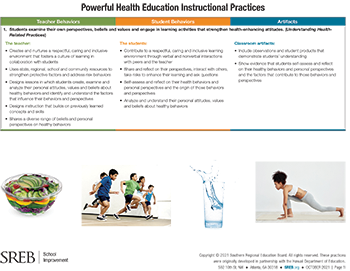Powerful Health Education Instructional Practices
 Teachers who follow SREB’s
Powerful Health Education Instructional
Practices draw on national, regional and local public
health data and other sources to identify priority health issues
for the local community. Then, the authentic learning experiences
teachers craft engage students in identifying the protective
factors, risk behaviors and health-enhancing behaviors that
influence these health issues and complete projects that require
them to problem-solve and implement changes to health behaviors
and practices at school and at home.
Teachers who follow SREB’s
Powerful Health Education Instructional
Practices draw on national, regional and local public
health data and other sources to identify priority health issues
for the local community. Then, the authentic learning experiences
teachers craft engage students in identifying the protective
factors, risk behaviors and health-enhancing behaviors that
influence these health issues and complete projects that require
them to problem-solve and implement changes to health behaviors
and practices at school and at home.
Students develop essential literacy skills — reading, writing, speaking, listening and thinking—as they formulate ideas and share different experiences and personal or cultural perspectives on health with their peers. Students create diverse oral, written or visual products to inform others about health-enhancing behaviors, such as interviews, podcasts, blogs, wellness plans, menus, scripts, ads or videos.
The Powerful Health Education Instructional Practices were originally developed by SREB in partnership with the Hawaii Department of Education and later refined by a team of SREB content-area experts to align with our full suite of Powerful Instructional Practices.
- Students examine their own perspectives, beliefs and values
and engage in learning activities that strengthen
health-enhancing attitudes. (Understanding Health-Related
Practices)
- Relevant, authentic learning experiences and assignments lead
students to practice and use health literacy skills.
(Adopting and Maintaining Health-Promoting
Behaviors)
- Lesson sequences within a unit are based upon the meaningful
skill development model and address concept and skill development
and mastery. (Supporting Health Skill Development)
- Focused learning targets and quality feedback advance
students’ understanding of health concepts and development of
health-enhancing skills. (Aligning Learning Targets to Unit
Expectations)
- Engaging learning strategies promote the progressive
development of skills and address learning expectations.
(Designing Engaging Instruction)
- Students meaningfully engage in participatory learning to apply health content knowledge and skills within the context of self, family and the community. (Connecting Health Practices Beyond the Classroom)

